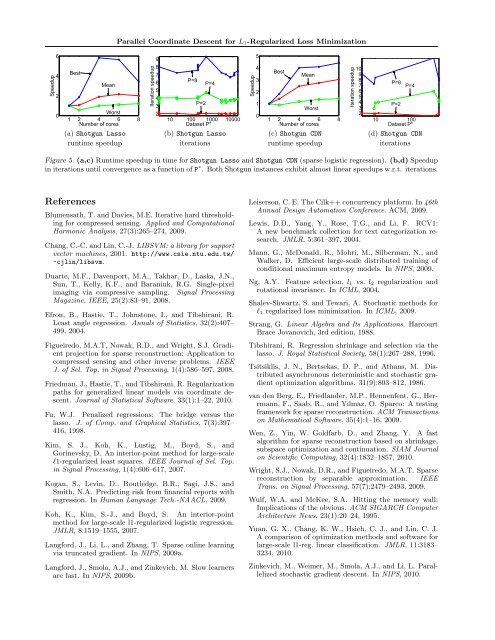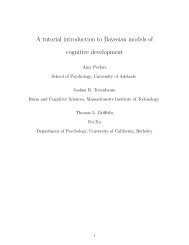Parallel Coordinate Descent for L1-Regularized Loss Minimization
Parallel Coordinate Descent for L1-Regularized Loss Minimization
Parallel Coordinate Descent for L1-Regularized Loss Minimization
You also want an ePaper? Increase the reach of your titles
YUMPU automatically turns print PDFs into web optimized ePapers that Google loves.
<strong>Parallel</strong> <strong>Coordinate</strong> <strong>Descent</strong> <strong>for</strong> L 1-<strong>Regularized</strong> <strong>Loss</strong> <strong>Minimization</strong><br />
Speedup<br />
6<br />
4<br />
2<br />
0<br />
Best<br />
Mean<br />
Worst<br />
1 2 4 6<br />
Number of cores<br />
8<br />
Iteration speedup<br />
9<br />
8<br />
7<br />
6<br />
5<br />
4<br />
3<br />
2<br />
P=8<br />
P=2<br />
P=4<br />
10 100 1000 10000<br />
Dataset P*<br />
Speedup<br />
5<br />
4<br />
3<br />
2<br />
1<br />
0<br />
Best<br />
Mean<br />
Worst<br />
1 2 4 6 8<br />
Number of cores<br />
Iteration speedup<br />
10<br />
9<br />
8<br />
7<br />
6<br />
5<br />
4<br />
3<br />
2<br />
P=8 P=4<br />
P=2<br />
10 100<br />
Dataset P*<br />
(a) Shotgun Lasso (b) Shotgun Lasso (c) Shotgun CDN (d) Shotgun CDN<br />
runtime speedup iterations runtime speedup iterations<br />
Figure 5. (a,c) Runtime speedup in time <strong>for</strong> Shotgun Lasso and Shotgun CDN (sparse logistic regression). (b,d) Speedup<br />
in iterations until convergence as a function of P ∗ . Both Shotgun instances exhibit almost linear speedups w.r.t. iterations.<br />
References<br />
Blumensath, T. and Davies, M.E. Iterative hard thresholding<br />
<strong>for</strong> compressed sensing. Applied and Computational<br />
Harmonic Analysis, 27(3):265–274, 2009.<br />
Chang, C.-C. and Lin, C.-J. LIBSVM: a library <strong>for</strong> support<br />
vector machines, 2001. http://www.csie.ntu.edu.tw/<br />
~cjlin/libsvm.<br />
Duarte, M.F., Davenport, M.A., Takhar, D., Laska, J.N.,<br />
Sun, T., Kelly, K.F., and Baraniuk, R.G. Single-pixel<br />
imaging via compressive sampling. Signal Processing<br />
Magazine, IEEE, 25(2):83–91, 2008.<br />
Efron, B., Hastie, T., Johnstone, I., and Tibshirani, R.<br />
Least angle regression. Annals of Statistics, 32(2):407–<br />
499, 2004.<br />
Figueiredo, M.A.T, Nowak, R.D., and Wright, S.J. Gradient<br />
projection <strong>for</strong> sparse reconstruction: Application to<br />
compressed sensing and other inverse problems. IEEE<br />
J. of Sel. Top. in Signal Processing, 1(4):586–597, 2008.<br />
Friedman, J., Hastie, T., and Tibshirani, R. Regularization<br />
paths <strong>for</strong> generalized linear models via coordinate descent.<br />
Journal of Statistical Software, 33(1):1–22, 2010.<br />
Fu, W.J. Penalized regressions: The bridge versus the<br />
lasso. J. of Comp. and Graphical Statistics, 7(3):397–<br />
416, 1998.<br />
Kim, S. J., Koh, K., Lustig, M., Boyd, S., and<br />
Gorinevsky, D. An interior-point method <strong>for</strong> large-scale<br />
l1-regularized least squares. IEEE Journal of Sel. Top.<br />
in Signal Processing, 1(4):606–617, 2007.<br />
Kogan, S., Levin, D., Routledge, B.R., Sagi, J.S., and<br />
Smith, N.A. Predicting risk from financial reports with<br />
regression. In Human Language Tech.-NAACL, 2009.<br />
Koh, K., Kim, S.-J., and Boyd, S. An interior-point<br />
method <strong>for</strong> large-scale l1-regularized logistic regression.<br />
JMLR, 8:1519–1555, 2007.<br />
Lang<strong>for</strong>d, J., Li, L., and Zhang, T. Sparse online learning<br />
via truncated gradient. In NIPS, 2009a.<br />
Lang<strong>for</strong>d, J., Smola, A.J., and Zinkevich, M. Slow learners<br />
are fast. In NIPS, 2009b.<br />
Leiserson, C. E. The Cilk++ concurrency plat<strong>for</strong>m. In 46th<br />
Annual Design Automation Conference. ACM, 2009.<br />
Lewis, D.D., Yang, Y., Rose, T.G., and Li, F. RCV1:<br />
A new benchmark collection <strong>for</strong> text categorization research.<br />
JMLR, 5:361–397, 2004.<br />
Mann, G., McDonald, R., Mohri, M., Silberman, N., and<br />
Walker, D. Efficient large-scale distributed training of<br />
conditional maximum entropy models. In NIPS, 2009.<br />
Ng, A.Y. Feature selection, l 1 vs. l 2 regularization and<br />
rotational invariance. In ICML, 2004.<br />
Shalev-Shwartz, S. and Tewari, A. Stochastic methods <strong>for</strong><br />
l 1 regularized loss minimization. In ICML, 2009.<br />
Strang, G. Linear Algebra and Its Applications. Harcourt<br />
Brace Jovanovich, 3rd edition, 1988.<br />
Tibshirani, R. Regression shrinkage and selection via the<br />
lasso. J. Royal Statistical Society, 58(1):267–288, 1996.<br />
Tsitsiklis, J. N., Bertsekas, D. P., and Athans, M. Distributed<br />
asynchronous deterministic and stochastic gradient<br />
optimization algorithms. 31(9):803–812, 1986.<br />
van den Berg, E., Friedlander, M.P., Hennenfent, G., Herrmann,<br />
F., Saab, R., and Yılmaz, O. Sparco: A testing<br />
framework <strong>for</strong> sparse reconstruction. ACM Transactions<br />
on Mathematical Software, 35(4):1–16, 2009.<br />
Wen, Z., Yin, W. Goldfarb, D., and Zhang, Y. A fast<br />
algorithm <strong>for</strong> sparse reconstruction based on shrinkage,<br />
subspace optimization and continuation. SIAM Journal<br />
on Scientific Computing, 32(4):1832–1857, 2010.<br />
Wright, S.J., Nowak, D.R., and Figueiredo, M.A.T. Sparse<br />
reconstruction by separable approximation. IEEE<br />
Trans. on Signal Processing, 57(7):2479–2493, 2009.<br />
Wulf, W.A. and McKee, S.A. Hitting the memory wall:<br />
Implications of the obvious. ACM SIGARCH Computer<br />
Architecture News, 23(1):20–24, 1995.<br />
Yuan, G. X., Chang, K. W., Hsieh, C. J., and Lin, C. J.<br />
A comparison of optimization methods and software <strong>for</strong><br />
large-scale l1-reg. linear classification. JMLR, 11:3183–<br />
3234, 2010.<br />
Zinkevich, M., Weimer, M., Smola, A.J., and Li, L. <strong>Parallel</strong>ized<br />
stochastic gradient descent. In NIPS, 2010.



